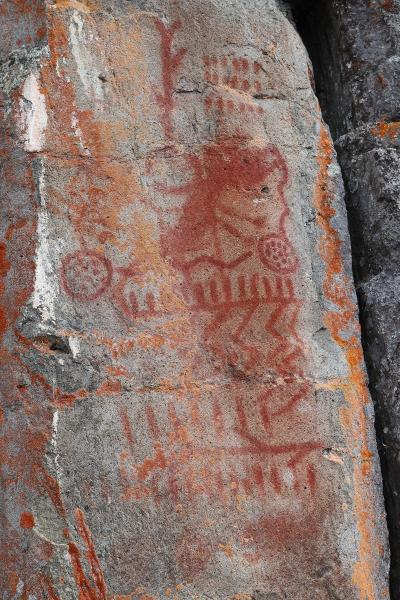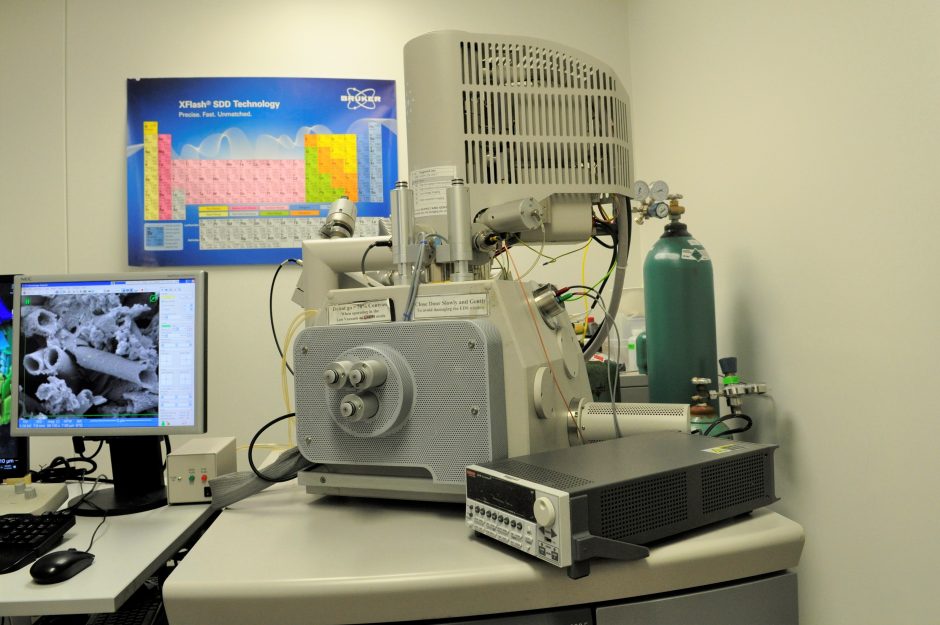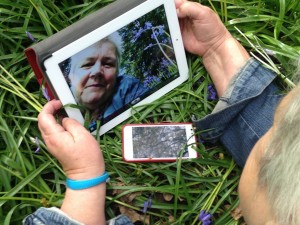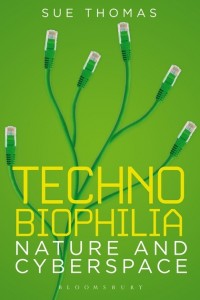A new generation of archaeologists and researchers may be getting ready to revise the history books. Brandi Lee MacDonald and her colleagues conducted research in the Babine Lake region of British Columbia (one of Canada’s 10 provinces; there are also three territories) on how the red pigment (ochre) used in the rock art that region was produced and they found something new. The people in that region don’t seem to have pulverized the rocks into powder as they did elsewhere. In the Babine Lake region, instead, they harvested aquatic sediment, heated the material to temperatures within a specific range, and eventually produced the dye you see on the rock art below.

A November 19, 2019 University of Missouri news release (also on EurekAlert and found as a Nov. 19, 2019 news item on ScienceDaily), describes the context for this research,
Ochre, one of Earth’s oldest naturally occurring materials, was often used as a vivid red paint in ancient rock art known as pictographs across the world. Despite its broad use throughout human history and a modern focus on how the artistic symbolism is interpreted, little research exists on the paint itself and how it was produced.
…
“Ochre is one of the only types of material that people have continually used for over 200,000 years, if not longer,” said MacDonald, who specializes in ancient pigments. “Therefore, we have a deep history in the archeological record of humans selecting and engaging with this material, but few people study how it’s actually made.”
Rock art: pictograph? petroglyph? geoglyph?
The image above shows a pictograph. MacDonald explains the difference between pictographs, petroglyphs, and geoglyphs. “A pictograph is something that’s painted, a petroglyph is stone that’s been carved, and a geoglyph is a pile of stones that have been assembled in a meaningful fashion.”
An archaeologist with a PhD from McMaster University (Hamilton, Ontario, Canada) and a special interest in pigments and rock art and their use in the Pacific Northwest and in the lower Canadian Shield, MacDonald noticed something interesting in the rock art of the Babine Lake region.
“I studied the ancient use of mineral pigments and found interesting chemical elements in the paint.” MacDonald’s observations indicated that the ochre didn’t have the same chemical signatures found in other samples.
What makes the ochre in the Babine Lake region different?
The November 19, 2019 University of Missouri news release provides a quote from MacDonald that could change how we view the use of technology in the Babine Lake region and elsewhere and may have implications for new, sustainable technologies,
“It’s common to think about the production of red paint as people collecting red rocks and crushing them up,” MacDonald said. “Here, with the help of multiple scientific methods, we were able to reconstruct the approximate temperature at which the people at Babine Lake were deliberately heating this biogenic paint over open-hearth fires. So, this wasn’t a transformation done by chance with nature. Today, engineers are spending a lot of money trying to determine how to produce highly thermo-stable paints for ceramic manufacturing or aerospace engineering without much known success, yet we’ve found that hunter-gatherers had already discovered a successful way to do this long ago.”
How do you study rock art?
That was my big question (although I may not have phrased it quite that way) when interviewing Brandi Lee MacDonald about her work,
“It’s challenging. The equipment we use is not very portable.”

“I take very tiny samples for microanalysis [analysis at the micro {one millionth of a metre}] scale] and always in consultation with the indigenous community (or communities). In fact, we try to take samples from previously damaged work.”
“In this case, I came across a small sample that was taken in the 1970s (a time when standards for asking for permissions were different) in the archive at the BC Royal Museum that we were able to use for our study. We addressed the 1970s situation by asking for permission this time.”
Once the researchers had taken a good look and confirmed there were significant chemical differences between the ochre found in the rock art of the Babine Lake area and the ochre found in rock art from other parts of the world, they tried to reproduce the process for deriving the ‘Babine Lake ochre pigment’. (Note: I’m coining a phrase, MacDonald did not use the term.)
The November 19, 2019 University of Missouri news release noted this about the ochre’s source,
This is the first study of the rock art at Babine Lake. It shows that individuals who prepared the ochre paints harvested an aquatic, iron-rich bacteria out of the lake — in the form of an orange-brown sediment.
Here’s what the researchers did to reproduce the ochre, from the Introduction to the paper; citation and link are at the end of this section of the posting (Note: Links have been removed),
We present here two important findings. Multiple independent lines of evidence unite to show that the individuals who prepared paints for rock art at Babine Lake harvested aquatic microbial iron mats dominated by iron-oxidizing bacteria (FeOB) […]. Those bacterial species produce biominerals with unique morphologies that can be long-lived31. This iron-rich material was homogenized and heated in large domestic hearths at a controlled range of approximately 750 °C to 850 °C; a technical gesture that was deliberately performed to enhance color properties, transforming orange-brown sediment to a vivid red hue. The heat treatment process converted the non-crystalline iron oxide minerals to crystalline forms resulting in increased colorfastness and resistance to degradation. This selective production of durable, colorfast, and highly thermostable biogenically-derived rock art paint represents a unique technological innovation. Our findings contribute to a growing body of literature on how hunter-gatherer communities in the Pacific Northwest possessed skilled ecological knowledge32. We also advance knowledge on the nanostructure, thermostability, and diagenesis of L. ochracea biomineral nanocomposites, with implications for the contemporary commercial production of renewable, thermostable, colorfast red pigments33,34.
As I understand it, researchers dried sediment from aquatic mats that are similar to those found in the Babine Lake region and then pulverized the dried sediment into a powder before reconstituting it with water (in time past, bear grease or salmon roe could also be used) to create a paint.
You can find out more about the research here (it’s an open access paper),
Hunter-Gatherers Harvested and Heated Microbial Biogenic Iron Oxides to Produce Rock Art Pigment by Brandi Lee MacDonald, David Stalla, Xiaoqing He, Farid Rahemtulla, David Emerson, Paul A. Dube, Matthew R. Maschmann, Catherine E. Klesner & Tommi A. White. Scientific Reports volume 9, Article number: 17070 (2019) Published: 19 November 2019
There are also nanoparticles
Studying the past can be a destructive process. no matter how careful you try to be. So to minimize any damage and, in addition to obtaining samples from previously damaged rock art, researchers use equipment that can provide measures at the microscale (one millionth) and nanoscale (one billionth). For example, the researchers were able to examine magnetite, maghemite, and hematite nanoparticles present on and in the FeOB (iron-oxidizing bacteria) samples.
Future directions
MacDonald is hoping to further the research, “I’d like to find out if this technology was only used in the Babine Lake region or whether it was more widespread. I’d also like to know when the technology was developed and over what time period it was used.”
“On a more practical basis, the indigenous community was excited that this technology might have applications in ceramic engineering.” MacDonald noted, “Researchers are very interested in sustainably-derived dyes that can withstand high temperature and retain their colour.”
It’s peculiarly satisfying to realize that this research into ochre and rock art could eventually lead to economic benefits for the indigenous community and surrounding region.
As well, it’s thrilling to think that ceramic engineers in Japan and elsewhere internationally who are actively hunting for environmentally friendly dyes that can be used for industrial purposes may find what they’re looking for in the distant past.



